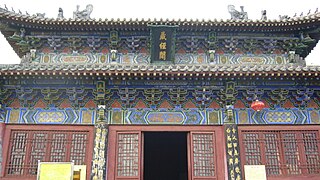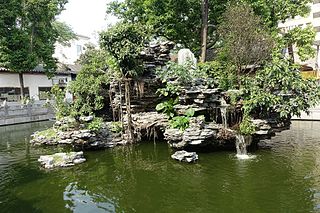
Donglin Temple is a Buddhist temple approximately 20 kilometres (12 mi) from Jiujiang,in the north of Jiangxi province,China. Built in 386 CE at the foot of Mount Lu by Huiyuan,founder of the Pure Land Buddhism,it is well known for how long it has stood without collapsing.

Puji Temple is a Buddhist temple located on the island of Putuoshan in Zhoushan,Zhejiang,China.

Huacheng Temple is the oldest and most prominent temple on Mount Jiuhua,Qingyang County,Anhui Province,China. It has a history of more than 1,500 years.

Qixia Temple is a Buddhist temple located on Qixia Mountain in the suburban Qixia District of Nanjing,Jiangsu,22 kilometres (14 mi) northeast of downtown Nanjing. It is one of Nanjing's most important Buddhist monasteries. The temple is the cradle of East Asian Mādhyamaka.

The Hall of Guru or Guru Hall,also known as the Founder's Hall,is the most important annex halls in Chinese Buddhist temples for enshrining masters of various Buddhism schools. It is encountered throughout East Asia,including in some Japanese Buddhist Kaisandos (開山堂). The Hall of Guru is generally situated to the west of the Mahavira Hall. Chan Buddhist temples usually have the Hall of Guru,which is followed by other schools' temples. Therefore,three statues are always enshrined in the Guru Hall,namely the founder of the school,the senior monk who make significant contributions to the establishment of the school and the builder of the temple. Generally the Guru Hall in Chan Buddhism temples has Bodhidharma enshrined in the middle,the 6th Master Huineng's (638-713) statue on the left and Master Baizhang Huaihai's (720-814) statue on the right. Patriarch Bodhidharma and Damo for short,from south of ancient India,was the original ancestor of Chan Buddhism. The 6th Master Dajian Huineng was the actual founder of Chan Buddhism. After him,the Chan Buddhism in ancient China was almost changed and had far-reaching influence on Chinese traditional culture. Baizhang Huaihai was the third generation disciple of Huineng and his main achievements included:applying Chan Buddhism into practice,creating a set of regulations for Chan Buddhist temples and contributing to the steady development of Chan Buddhism.

The Hall of Guanyin or Guanyin Hall is the most important annex halls in Chinese Buddhist temples and mainly for enshrining Guanyin (Avalokiteśvara). Guanyin,also called "Guanshiyin" (觀世音),"Guanshizizai" (觀世自在),"Guanzizai" (觀自在),etc.,is the attendant of Amitabha and one of the "Western Three Saints" (西方三聖). Guanyin is renowned for his mercy and sympathy. According to Chapter of the Universal Gate of Avalokiteśvara Bodhisattva (《觀世音菩薩普門品》),if people are in danger,they just need to call his name and he will hear them and go to save them. Since he has many manifestations,different places enshrine different statues of Saint Guanyin (圣觀音),Guanzizai (觀自在),and Thousand-armed and eyed Guanyin (千手千眼觀音菩薩).

A Buddhist texts library is a large building in Chinese Buddhist temples which is built specially for storing The Chinese Buddhist Canon (大藏經). It is encountered throughout East Asia,including in some Japanese Buddhist Kyōzōs (経蔵). The Chinese Buddhist Canon is the total body of Buddhist literature deemed canonical and was called "all the sutras" (一切經) in the ancient time. With four thousand kinds,it includes Āgama (經),Vinaya (律) and Abhidharma (論) texts. Āgama are theories made by Buddha for disciples to practice,Vinaya are the rules formulated by Buddha for believers and Abhidharma is the collection of theories explanations by Buddha's disciples.

The Dharma Hall,also known as Lecture Hall,is an important building in Han Chinese Buddhist temples. The Dharma Hall is the place for senior monks to preach and generally ranks right after the Mahavira Hall.

The Xiantong Temple is a Buddhist temple located in Taihuai Town of Wutai County,Shanxi,China. The temple covers a total area of about 80,000 square metres (860,000 sq ft),it preserves the basic architectural pattern of the Ming and Qing dynasties (1368–1912). The temple has over 400 buildings and the seven main halls along the central axis are the Guanyin Hall,Great Manjusri Hall,Great Buddha Hall,Amitaba Hall,Qianbo Hall,Copper Hall and Buddhist Texts Library. Mount Wutai has 47 Buddhist temples,it is the largest Buddhist complex in China,Xiantong Temple is the largest one with the longest history.
Mange Temple is a Buddhist temple located in Jinghong of Xishuangbanna Dai Autonomous Prefecture,Yunnan,China. Covering an area of 1,300-square-metre (0.32-acre),the temple is bordered by Lancang River in the north. Built in 1477,the temple is one of the oldest temples in Xishuangbanna Dai Autonomous Prefecture.

Wannian Temple is a Buddhist temple located at the foot of Camel Mountain Range of Mount Emei,in Emeishan City,Sichuan,China. It is one of the six earliest Buddhist temples on Mount Emei. The temple is situated at the foot of Camel Mountain Range,facing the Daping Temple,Niuxin Temple,Shisun Summit and Bomeng Summit (钵孟峰) in the front. Wannian Temple is known not only for the bronze statue of Samantabhadra,but also for the Beamless Brick Hall.

The Shrine of Living Buddha is a Buddhist temple located at the Divine Light Summit (神光岭) of Mount Jiuhua,in Qingyang County,Anhui,China.

Zhiyuan Temple is a Buddhist temple located on Mount Jiuhua,in Qingyang County,Anhui,China. Alongside Ganlu Temple,Baisui Palace and Dongyan Chan Temple are honoured as the "Four Buddhist Temple on Mount Jiuhua".

Daci'en Temple is a Buddhist temple located in Yanta District,Xi'an,Shaanxi. The temple is the cradle of East Asian Yogācāra in China. It is notable for the Giant Wild Goose Pagoda. The pagoda was originally built under the supervision of the monk Xuanzang,whose pilgrimage to India inspired the novel Journey to the West. Alongside Daxingshan Temple and Jianfu Temple,it was one of the three sutras translation sites (三大译经场) in the Tang dynasty.

Meidaizhao Monastery or Meidaizhao Lamasery is a Tibetan Buddhist temple located in Tumed Right Banner,Baotou,Inner Mongolia,China.

The Hall of Sangharama Palace is an important building in Han Chinese Buddhist temples. It is the east annex hall of the Mahavira Hall. The term "Sangharama" (僧伽藍摩) refers to "gardens of monks" (眾園). In Buddhism,it originally refers to constructing the base of monks' dormitories (僧舍) and later it refers to the general term of temples,including land and buildings.
The Arhat Hall is a hall used for enshrining an arhat or arhats in Chinese Buddhist temples. Arhat is another term for Arahant,one who has gained insight into the true nature of existence and has achieved Enlightenment and liberated from the endless cycle of rebirth. In Mahayana Buddhism,arhats rank the third position in Buddhism,only below the Buddhas and Bodhisattvas. In Theravada Buddhism,Siddhartha Gautama or The Buddha is the first of the arahats,while his disciples who reach the goal by following his noble path also become arahats.

A Free Life Pond is a type of pond at Han Chinese Buddhist temples. It is usually located in front of the Shanmen or the Hall of Four Heavenly Kings. The Free Life Pond embodies Buddhist thoughts of compassion and understanding of all living beings.
The Hall of Bhaisajyaguru is the hall to enshrine Bhaisajyaguru,who is also named "Yaoshifo" for short in Chinese Buddhism.

The drum tower is an important building in Han Chinese Buddhist temples. Together with a bell tower,they are usually placed on both sides of the Hall of Four Heavenly Kings. It is usually located on the right side while the bell tower is usually located on the left side. Generally,it is a three-storey pavilion with a big drum placed on it. When it is beaten,it sounds grandly and loudly. Buddhist temples set times to beat the drums to inform the time and also wake people up.

















